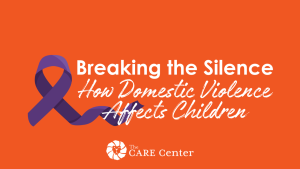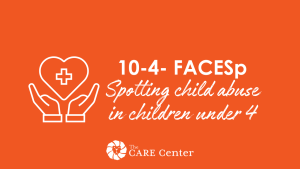Child abuse is an act that endangers or impairs a child’s physical, mental or emotional health and development. Child abuse may take the form of physical or emotional injury, sexual abuse, sexual exploration, physical neglect, medical neglect, or inadequate supervision. Child victims are often abuse by someone they know or by someone is a position of authority. Abuse knows now boundaries as it occurs in all economic groups, across all margins.
The following are signs commonly associated with abuse, but they are not absolutes. This list is not a checklist but a guide to help us identify abuse when it is present.
Physical Abuse
- Frequent injuries that are unexplained and/or when the child or parent cannot adequately explain their causes such as: bruises, cuts, black eyes, fractures, burns
- Burns or bruises in an unusual pattern that may indicate the use of an instrument
- Lack of reaction to pain
- Injuries that appear after the child has not been seen for several days
- Evidence of delayed or inappropriate treatment for injuries
- Injuries involve the face, backs of hands, buttocks, genital area, abdomen, back, or sides of the body
- Frequent complaints of pain without obvious injury
- Complaints of soreness or uncomfortable when moving
- Aggressive, disruptive and destructive or self-destructive behavior
- Passive, withdrawn, emotionless behavior
- Fear of going home or seeing parents
Neglect
- Obvious mal-nourishment or inadequate nutrition
- Lack of personal cleanliness Torn and/or dirty clothes
- Need for glasses, dental care or other unattended medical attention
- Consistent hunger, stealing or begging for food
- Distended stomach, emaciated
- Lack of supervision for long periods of time
- Frequent absence or tardiness from school
- Regularly displays fatigue or listlessness or falls asleep in class
- Reports that no caretaker is at home
- Self-destructive behavior
- Extreme loneliness and need for affection
Emotional Abuse
- Speech disorders
- Delayed physical development
- Substance abuse
- Ulcers, asthma, severe allergies
- Habit disorders (sucking, rocking, biting)
- Antisocial, destructive behaviors
- Delinquent behaviors (especially adolescents)
- Developmentally delayed
Sexual Abuse
- Torn, stained or bloody underclothing
- Pain, swelling or itching in genital area
- Difficulty walking or sitting
- Excessive seductiveness, inappropriate sex play or premature understanding of sex
- Role reversal, overly concerned for siblings
- Significant weight change
- Suicide attempts (especially adolescents)
- Threatened by physical contact, closeness
- Extreme fear of being alone with adults especially if of a particular gender
- Sudden refusal to change for gym or to participate in physical activities
- Sexual victimization of other children
- Major change in normal mood or behavior
If you suspect any of the above signs or symptoms of abuse, please call the Oklahoma 24-Hour Hotline or call 911 if the child is in immediate danger.
To report abuse
If you suspect abuse, please report it. You may be the only one a child can count on!
Oklahoma 24-Hour Hotline 1-800-522-3511
National Hotline 1-800-4ACHILD
If a child is in immediate danger, call 911.
State law requires every person who has reason to believe that a child is being abused or is in danger of being abused to report the suspicion of abuse.
A report of suspected child abuse is a request for an investigation to gather facts and protect the child from further harm. The person reporting the abuse does not need to prove abuse prior to reporting. Investigation and determination of abuse are the responsibility of DHS, law enforcement, and the judicial system.



